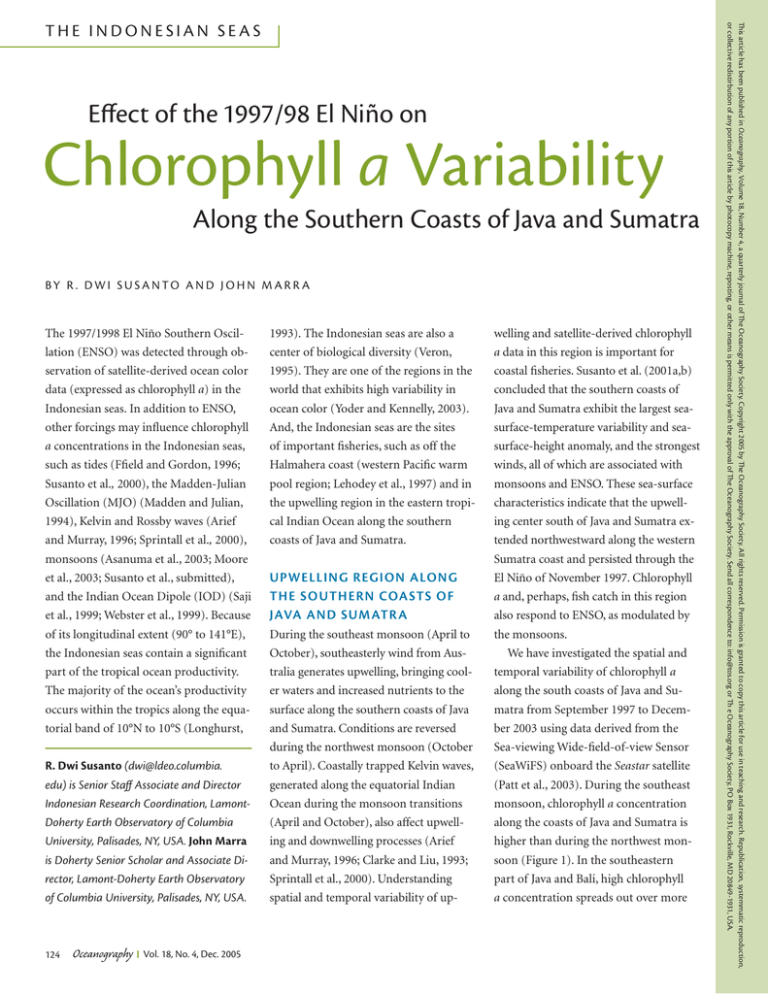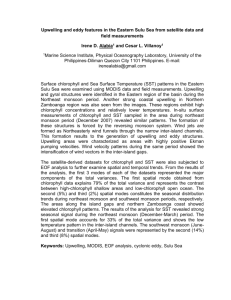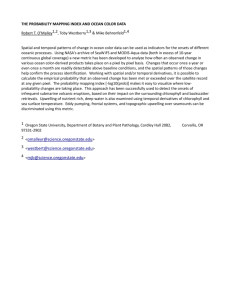
Effect of the 1997/98 El Niño on
Chlorophyll a Variability
Along the Southern Coasts of Java and Sumatra
BY R . DWI SUSANTO AN D J O H N M AR R A
The 1997/1998 El Niño Southern Oscillation (ENSO) was detected through observation of satellite-derived ocean color
data (expressed as chlorophyll a) in the
Indonesian seas. In addition to ENSO,
other forcings may influence chlorophyll
a concentrations in the Indonesian seas,
such as tides (Ffield and Gordon, 1996;
Susanto et al., 2000), the Madden-Julian
Oscillation (MJO) (Madden and Julian,
1994), Kelvin and Rossby waves (Arief
and Murray, 1996; Sprintall et al., 2000),
monsoons (Asanuma et al., 2003; Moore
et al., 2003; Susanto et al., submitted),
and the Indian Ocean Dipole (IOD) (Saji
et al., 1999; Webster et al., 1999). Because
of its longitudinal extent (90° to 141°E),
the Indonesian seas contain a significant
part of the tropical ocean productivity.
The majority of the ocean’s productivity
occurs within the tropics along the equatorial band of 10°N to 10°S (Longhurst,
R. Dwi Susanto (dwi@ldeo.columbia.
edu) is Senior Staff Associate and Director
Indonesian Research Coordination, LamontDoherty Earth Observatory of Columbia
University, Palisades, NY, USA. John Marra
is Doherty Senior Scholar and Associate Director, Lamont-Doherty Earth Observatory
of Columbia University, Palisades, NY, USA.
124
Oceanography
Vol. 18, No. 4, Dec. 2005
1993). The Indonesian seas are also a
center of biological diversity (Veron,
1995). They are one of the regions in the
world that exhibits high variability in
ocean color (Yoder and Kennelly, 2003).
And, the Indonesian seas are the sites
of important fisheries, such as off the
Halmahera coast (western Pacific warm
pool region; Lehodey et al., 1997) and in
the upwelling region in the eastern tropical Indian Ocean along the southern
coasts of Java and Sumatra.
UPWELLING REGION ALONG
THE SOUTHERN COASTS OF
JAVA AND SUMATR A
During the southeast monsoon (April to
October), southeasterly wind from Australia generates upwelling, bringing cooler waters and increased nutrients to the
surface along the southern coasts of Java
and Sumatra. Conditions are reversed
during the northwest monsoon (October
to April). Coastally trapped Kelvin waves,
generated along the equatorial Indian
Ocean during the monsoon transitions
(April and October), also affect upwelling and downwelling processes (Arief
and Murray, 1996; Clarke and Liu, 1993;
Sprintall et al., 2000). Understanding
spatial and temporal variability of up-
welling and satellite-derived chlorophyll
a data in this region is important for
coastal fisheries. Susanto et al. (2001a,b)
concluded that the southern coasts of
Java and Sumatra exhibit the largest seasurface-temperature variability and seasurface-height anomaly, and the strongest
winds, all of which are associated with
monsoons and ENSO. These sea-surface
characteristics indicate that the upwelling center south of Java and Sumatra extended northwestward along the western
Sumatra coast and persisted through the
El Niño of November 1997. Chlorophyll
a and, perhaps, fish catch in this region
also respond to ENSO, as modulated by
the monsoons.
We have investigated the spatial and
temporal variability of chlorophyll a
along the south coasts of Java and Sumatra from September 1997 to December 2003 using data derived from the
Sea-viewing Wide-field-of-view Sensor
(SeaWiFS) onboard the Seastar satellite
(Patt et al., 2003). During the southeast
monsoon, chlorophyll a concentration
along the coasts of Java and Sumatra is
higher than during the northwest monsoon (Figure 1). In the southeastern
part of Java and Bali, high chlorophyll
a concentration spreads out over more
This article has been published in Oceanography, Volume 18, Number 4, a quarterly journal of The Oceanography Society. Copyright 2005 by The Oceanography Society. All rights reserved. Permission is granted to copy this article for use in teaching and research. Republication, systemmatic reproduction,
or collective redistirbution of any portion of this article by photocopy machine, reposting, or other means is permitted only with the approval of The Oceanography Society. Send all correspondence to: info@tos.org or Th e Oceanography Society, PO Box 1931, Rockville, MD 20849-1931, USA.
THE INDONESIAN SEAS
rophyll a in both magnitude and timing
of the seasonal response to the southeast
monsoon. During the El Niño, ocean
color intensifies in the upwelling region
along the southern coasts of Java and Sumatra. The area of increased ocean color
extends westward, prolonging the southeast monsoon period.
To understand the temporal variability of chlorophyll a along these coasts,
we calculated average chlorophyll a values from the coast to 200 km offshore
(Figure 2). Higher chlorophyll a con-
Figure 1. (a) Average chlorophyll a concentration derived from SeaWiFS from January
1998 to December 2003 during the northwest monsoon (December–February, or DJF).
(b) Average chlorophyll a concentration during the southeast monsoon (June–August,
or JJA). Southeasterly winds from Australia induce upwelling, bringing cooler and highernutrient waters to the surface along the south coasts of Java and Sumatra. Hence, chlorophyll a concentrations are higher in comparison to those during the northwest monsoon.
than 2° latitude (approximately 220 km)
from the coast. Susanto et al. (submitted)
concluded that ocean-color variability
in the Indonesian region is affected by
the monsoons and interannual forcing
associated with ENSO and the IOD, par-
ticularly in the upwelling region along
the coasts of Java and Sumatra, and the
Banda Sea. Specifically, the 1997/1998 El
Niño/La Niña events coincided with the
IOD, producing significant departures
from the six-year monthly mean chlo-
centration corresponds very well with
monsoon-generated upwelling during
the southeast monsoon cycle. During
the southeast monsoon in a normal year,
high chlorophyll a extends only to the
southern tip of Sumatra. Interannual
variability can be clearly seen in Figure
2, as indicated by Niño3.4 and Indian
Ocean Dipole indices.
During the peak of the 1997/1998 El
Niño, anomalous easterly winds induced
strong upwelling, brought cooler water, and lifted the thermocline to depths
much shallower than the climatological
mean along the coasts of Java and Sumatra (Susanto et al., 2001a,b). This event
produced higher chlorophyll a concentrations that extended further northwestward along the Sumatra coast (Figure 2).
The average chlorophyll a anomaly
during the peak of the 1997/98 El Niño
(October–December 1997) is shown in
Figure 3. Monthly anomalies were computed as departures from the 1998–2003
mean for that month. A higher chlorophyll a anomaly was observed in the
southeastern part of the region than that
further west. Temporal variability of
the chlorophyll a concentration in the
Sunda and Bali Straits are shown in Fig-
Oceanography
Vol. 18, No. 4, Dec. 2005
125
Chlorophyll−a
Nino3.4 Index
2004
IOD Index
2004
1.5
2004
1
2003
2003
0.75
2003
0.5
2002
2002
2002
0.45
2001
2001
2001
0.35
0.3
2000
2000
Chl−a (mg m−3)
0.4
2000
Figure 2. Temporal variability of chlorophyll a
concentration along the southern coasts of Java
and Sumatra (refer to Figure 1 to correlate longitude with the location of these two islands).
Higher chlorophyll a concentrations are matched
very well with the upwelling during the southeast
monsoon cycle. Interannual variability associated
with the 1997/1998 El Niño, which coincided with
Indian Ocean Dipole, produced higher chlorophyll
a concentrations that extended further northwestward along the Sumatra coast. Note that the
increase in ocean color between 2000 and 2003
may signal an increase in the monsoonal winds
(Goes et al., 2005). The Niño3.4 index defines an
average sea-surface-temperature anomaly within
the region 120°W–170°W and 5°N–5°S. The Indian
Ocean Dipole index is defined as the difference
in sea-surface-temperature anomaly between the
tropical western Indian Ocean (50°E–70°E, 10°S–
10°N) and the tropical southeastern Indian Ocean
(90°E–110°E, 10°S–Equator) (Saji et al., 1999).
0.25
0.2
1999
1999
1999
0.15
1998
1998
0.1
1998
0.05
100
105
110
Longitude (oE)
115
1997
−2
0
2
1997
−2
4
−1°N
0
0
Kalimantan
−2°N
Sumatra
−3°N
−4°N
−5°N
−6°N
−7°N
Java
−8°N
−9°N
−10°N
−11°N
100°E
126
Oceanography
102.5°E
105°E
107.5°E
Vol. 18, No. 4, Dec. 2005
110°E
112.5°E
115°E
2
8
6
5
4
3
2
1. 5
1
0.75
0. 5
0.25
0
−0.25
−0.5
−0.75
−1
−1.5
−2
−3
−4
−5
−6
−8
Chl−a (mg m-3)
1997
Figure 3. Satellite-derived chlorophyll a anomaly
during the peak of the 1997/98 El Niño from
October to December 1997. Monthly anomalies
were computed as departures from the 1998-2003
mean for that month. Anomalous easterly winds
during the 1997/98 El Niño coincided with Indian
Ocean Dipole (IOD), which generated anomalous
upwelling and produced a significant departure of
chlorophyll a concentrations along the southern
coasts of Java and Sumatra.
1998
2000
2002
2004
3
4.5
Chl−a Sunda Strait
4
2
Chl−a Bali Strait
1
IOD Index
3
0
2.5
−1
2
−2
1.5
−3
1
−4
0.5
−5
0
1997
1998
1999
2000
2001
2002
2003
Nino3.4 and IOD Indices
Chl−a concentration (mg/m3)
3.5
−6
2004
Figure 4. Temporal variability of SeaWiFS-derived chlorophyll a in the Sunda Strait (blue)
and Bali Strait (red), overlain with interannual indices, Niño3.4 index (shaded in magenta
and cyan) and Indian Ocean Dipole index (black). The seasonal variability associated with
monsoon and interannual variability associated with 1997/1998 El Niño and Indian Ocean
Dipole as indicated by the Niño3.4 and IOD indices are clearly seen.
ure 4. Again, clearly seen is the seasonal
variability associated with monsoon and
interannual variability associated with
1997/1998 El Niño and Indian Ocean
Dipole as indicated by the Niño3.4 and
IOD indices. The impact of the ENSO
cycle on pelagic fish remains to be determined. Catches of small pelagics (e.g.,
anchovy, sardine) likely follow the temporal variability in chlorophyll a.
In summary, the strong 1997/1998
El Niño followed by a La Niña period,
which also coincided with an Indian
Ocean Dipole event, was associated with
higher chlorophyll a values in the upwelling region along the southern coasts of
Java and Sumatra. Higher chlorophyll a
values were observed during the southeast monsoon cycle (April–October) than
during the northwest monsoon cycle.
ACKNOWLED GEMENTS
This research was funded by the Office
of Naval Research (ONR) under grants
N00014-04-1-0698 and N00014-05-10272, the International Research Institute
for Climate Prediction (IRI) Seed funds,
and National Aeronautics and Space
Administration (NASA) Grant NNG04GM83G. Lamont-Doherty Earth Observatory contribution number 6830.
REFERENCE S
Arief, D., and S.P. Murray. 1996. Low-frequency fluctuations in the Indonesian throughflow through
Lombok Strait. Journal of Geophysical Research
101:12,455–12,464.
Asanuma, I., K. Matsumoto, H. Okano, T. Kawano, N.
Hendiarti, and S. Sachoemar. 2003. Spatial distribution of phytoplankton along the Sunda Islands: The
monsoon anomaly in 1998. Journal of Geophysical
Research 108(3202), doi:10.1029/1999JC000139.
Clarke, A.J., and X. Liu. 1993. Observations and dynamics of semiannual and annual sea levels near the
eastern Indian Ocean boundary. Journal Physical
Oceanography 23:386–399.
Ffield, A., and A.L. Gordon. 1996. Tidal mixing signatures in the Indonesian Seas. Journal of Physical
Oceanography 26:1,924–1,937.
Goes, J.I., P.G. Thoppil, H. do R. Gomes, J.T. Fasullo.
2005. Warming of the Eurasian landmass is making
the Arabian Sea more productive. Science 308:545–
547.
Lehodey, P., M. Bertignac, J. Hampton, A. Lewis, and J.
Picaut. 1997. El Nino southern oscillation and tuna
in the western Pacific. Nature 39:715–718.
Longhurst, A. 1993. Seasonal cooling and blooming in
tropical oceans. Deep-Sea Research I 40:2,145–2,165.
Madden, R.A., and P.R. Julian. 1994. Observations of the
40–50 day tropical oscillation—A review. Monthly
Weather Reviews 122:814–837.
Moore, T.S. II, J. Marra, and A. Alkatiri. 2003. Response
of the Banda Sea to the Southeast monsoon. Marine
Ecology Progress Series 261:41–49.
Patt, F.S., R.A. Barnes, R.E. Eplee, Jr., B.A. Franz, W.D.
Robinson, G.C. Feldman, S.W. Bailey, J. Gales, P.J.
Werdell, M. Wang, R. Frouin, R.P. Stumpf, R.A.
Arnone, R.W. Gould, Jr., P.M. Martinolich, V. Ransibrahmanakul, J.E. O’Reilly, and J.A. Yoder. 2003.
Algorithm Updates for the Fourth SeaWiFS Data Reprocessing. NASA Technology Memorandum. 2003206892. Vol. 22. S.B. Hooker and E.R. Firestone, eds.
NASA Goddard Space Flight Center, Greenbelt, MD,
74 pp.
Saji, N.H., B.N. Goswami, P.N. Vinayachandran, and T.
Yamagata. 1999. A dipole mode in the tropical Indian Ocean. Nature 401:360–363.
Sprintall, J., A.L. Gordon, R. Murtugudde, and R.D.
Susanto. 2000. A semi-annual Indian Ocean forced
Kelvin waves observed in the Indonesian Seas, May
1997. Journal of Geophysical Research 105:17,217–
17,230.
Susanto, R.D, T. Moore II, and J. Marra. Submitted.
Ocean color variability in the Indonesian Seas during the SeaWiFS era. Geochemistry Geophysics Geosystems.
Susanto, R.D., A.L. Gordon, and Q. Zheng. 2001a. Upwelling along the coasts of Java and Sumatra and
its relation to ENSO. Geophysical Research Letters
28:1,559–1,602.
Susanto, R.D., A.L. Gordon, and Q. Zheng. 2001b. Upwelling within the Indonesian Seas and its relation
to Monsoon and ENSO. The Fifth IOC/WESTPAC
International Scientific Symposium, Seoul, Republic
of Korea, August 27–31.
Susanto, R.D., A.L. Gordon, J. Sprintall, and B. Herunadi.
2000. Intraseasonal variability and tides in Makassar
Strait. Geophysical Research Letters 27:1,499–1,502.
Veron, J.E.N. 1995. Corals in Space and Time: Biography
and Evolution of the Scleractinia Cornell University
Press, Ithaca, NY, 321 pp.
Webster, P.J., A.M. Moore, J.P. Loschnigg, and R.R.
Leben. 1999. Coupled ocean-atmosphere dynamics in the Indian Ocean during 1997–98. Nature
401:356–360.
Yoder, J.A., and M.A. Kennelly. 2003. Seasonal and
ENSO variability in global ocean phytoplankton
chlorophyll derived from 4 years of SeaWiFS measurements. Global Biogeochemistry Cycles 7(1112),
doi:10.1029/2002GB001942.
Oceanography
Vol. 18, No. 4, Dec. 2005
127


